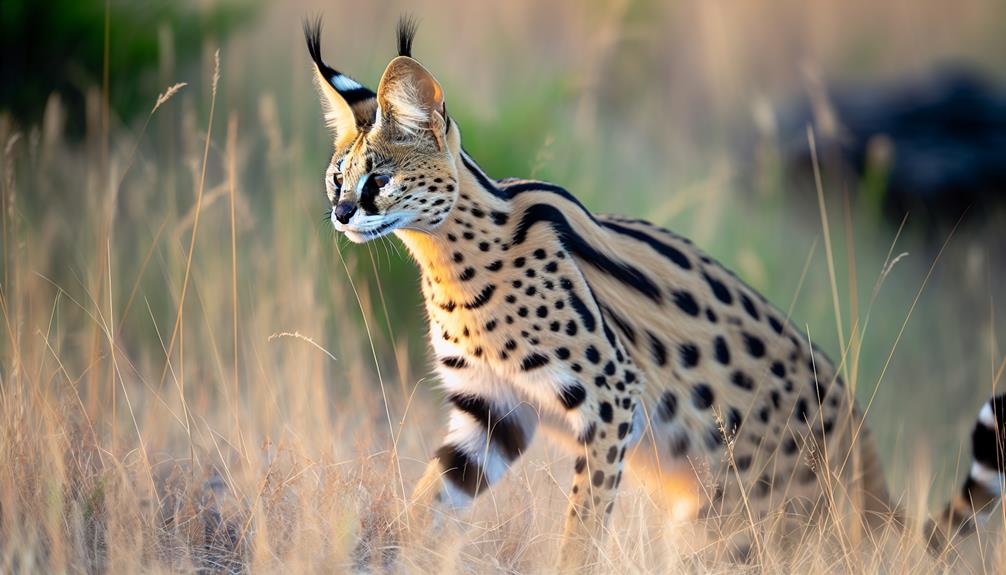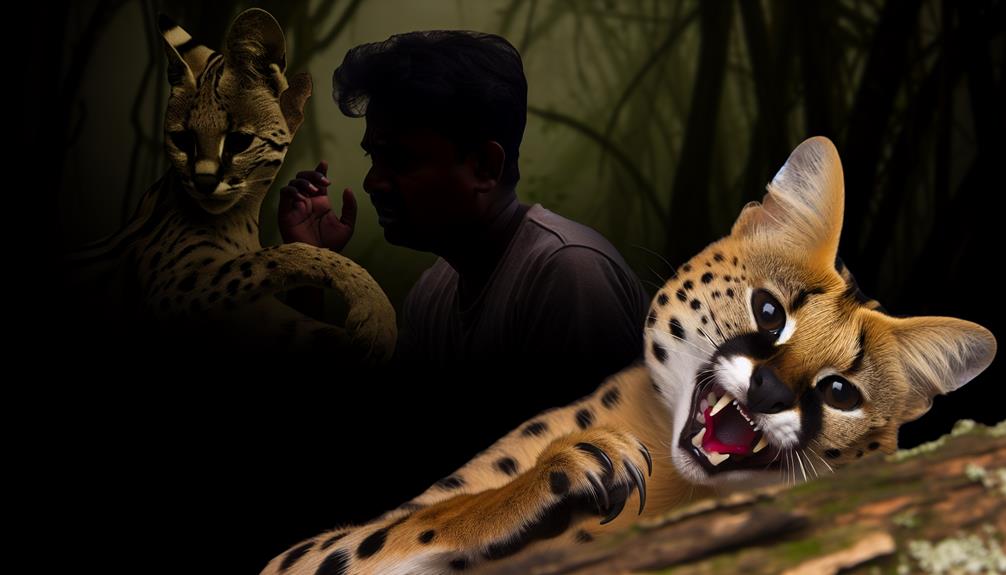Much like the myth of the dangerous lion in 'Aesop's Fables,' the question of whether a serval cat can kill a human often stirs curiosity and concern. When considering their sharp claws and strong predatory instincts, it's tempting to imagine the worst. However, servals typically avoid humans and focus their hunting on small mammals and birds. So, what happens if a serval feels threatened or provoked? Understanding their natural behavior and the precautions you can take might offer some surprising insights.
Understanding Serval Cats
Understanding serval cats requires a look into their natural habitat, physical characteristics, and behavioral tendencies. These African wildcats mainly inhabit the savannas, wetlands, and grasslands of Sub-Saharan Africa. Serval habitats are characterized by tall grasses and dense vegetation, which provide ample cover for hunting and protection from predators. They thrive in areas with abundant water sources, as these environments support their prey, including rodents, birds, and insects.
When examining their social structures, you'll notice that servals are largely solitary animals. Unlike lions or cheetahs, servals don't form social groups. They maintain and defend territories that range from 4 to 12 square kilometers, marking them with scent glands and urine. Male servals have larger territories that often overlap with those of several females, facilitating mating opportunities. However, direct interactions between servals are rare and usually limited to mating or territorial disputes.
Behaviorally, servals exhibit a crepuscular activity pattern, meaning they are most active during the dawn and dusk hours. This activity period aligns with the times when their prey is also most active, optimizing their hunting success. Regarding communication, servals use a variety of vocalizations, including growls, purrs, and hisses, alongside body language to convey their intentions and establish dominance.
Physical Capabilities
The physical capabilities of serval cats are both remarkable and specialized for their survival in the wild. These medium-sized felines possess a unique combination of physical strength and agility that permit them to effectively hunt and evade predators. Servals stand out due to their long legs and large ears, which aid in detecting and capturing prey.
In terms of physical strength, servals have a lean but muscular build. Their powerful hind legs can propel them to leap up to 3 meters vertically, allowing them to catch birds in mid-air. This impressive jumping ability is complemented by their speed, as they can sprint at speeds of up to 50-60 kilometers per hour. Such physical prowess guarantees they can quickly close in on prey or escape potential threats.
Sharp claws are another critical aspect of a serval's physical toolkit. These retractable claws are used for gripping and subduing prey, as well as for climbing and defending themselves. The claws, combined with strong jaw muscles and sharp teeth, enable servals to efficiently deliver a fatal bite to smaller animals. However, these features are primarily adapted for hunting small to medium-sized prey, such as rodents, birds, and insects.
It's important to note that, despite their physical capabilities, servals are generally not a threat to humans. Their natural behavior is to avoid human contact, and their physical traits are not geared toward attacking large animals like humans. While their sharp claws can cause injury if threatened or cornered, the likelihood of a serval cat killing a human is exceedingly low, given their size and typical prey preferences.
Natural Behavior

When examining a serval cat's natural behavior, you'll notice their strong hunting instincts, often displayed through stalking and pouncing on prey. Interaction with humans can vary, but servals typically remain cautious and may exhibit territorial aggression if they feel threatened. Understanding these behaviors is vital to evaluating any potential risks to humans.
Hunting Instincts Displayed
Among the various attributes of a serval cat, its hunting instincts are particularly remarkable. You'll notice these wild felines exhibit an array of sophisticated hunting techniques. They are known for their exceptional leap, capable of springing up to 3 meters to snatch birds mid-flight. Their elongated legs and large ears play vital roles in their hunting efficacy, allowing them to detect and capture prey with precision.
In terms of prey preference, servals primarily target small mammals, birds, frogs, insects, and fish. They demonstrate a remarkable ability to adapt their hunting methods based on the type and behavior of the prey. For instance, when hunting rodents, servals rely on their acute hearing to detect movements in the grass, followed by a swift pounce. Conversely, when targeting birds, they often employ a more stealthy approach, leveraging their camouflage to get as close as possible before launching their impressive leap.
Interaction With Humans
Despite their wild nature, serval cats generally exhibit a cautious demeanor around humans. This characteristic is primarily due to their instinctual behavior and natural environment, which conditions them to be wary of potential threats. Human serval interactions are often marked by an initial period of mutual observation and distance. Servals, being solitary and territorial animals, don't naturally seek out human companionship.
In captivity, serval socialization can vary considerably based on their upbringing and the presence of consistent human interaction. Here are four key points to reflect on for understanding serval behavior around humans:
- Caution and Curiosity: Servals tend to approach humans with a mix of caution and curiosity, often maintaining a safe distance initially.
- Habituation Potential: With consistent positive interactions, servals can become more comfortable around humans, though complete domestication remains unlikely.
- Stress Responses: Unexpected movements or loud noises can trigger stress responses in servals, leading to defensive behavior.
- Behavioral Conditioning: Over time, servals may learn to associate humans with food and care, which can reduce their natural wariness but not eliminate their wild instincts.
Understanding these interactions helps in managing serval cats both in captivity and when encountered in the wild.
Territorial Aggression Signs
Territorial aggression in serval cats manifests through a series of distinct behaviors that serve to establish and defend their domain. You'll notice these wild felines marking their territory with urine, feces, and glandular secretions. These territorial markings are not random but strategically placed to communicate ownership and deter intruders. The markings also play a vital role in the social hierarchy of serval populations, signaling dominance and reproductive status.
When a serval cat perceives a threat to its territory, it adopts a heightened state of aggression. You'll observe signs like flattened ears, arched back, and vocalizations such as growls or hisses. These behaviors are intended to intimidate potential competitors or predators. Physical confrontations can occur if these initial warnings are ignored, though servals generally prefer to avoid direct conflict.
Understanding these territorial aggression signs is essential for anyone interacting with serval cats, whether in the wild or captivity. Misinterpreting or overlooking these behaviors can lead to dangerous situations, escalating the animal's stress and potential for aggressive actions. By recognizing the importance of territorial markings and social hierarchy, you can better appreciate the natural behavior of serval cats and minimize risk.
Serval Cats as Pets
If you're considering a serval cat as a pet, it's essential to understand the legal ownership requirements, as regulations vary by location. These animals have specific behavior and temperament that can be challenging to manage. Additionally, their care and maintenance demand significant time, resources, and specialized knowledge.
Legal Ownership Requirements
Owning a serval cat comes with a myriad of legal requirements that vary considerably by region. Before acquiring one, you'll need to navigate through a complex web of legal regulations and understand your ownership responsibilities. Here's a concise breakdown of what you need to take into account:
- Permits and Licenses: Many regions require specific permits or licenses to own exotic pets like serval cats. Check with local wildlife agencies to verify compliance.
- Zoning Laws: Some areas have zoning regulations that either restrict or completely prohibit the ownership of serval cats. Review local zoning laws to confirm if owning a serval cat is allowed in your area.
- Insurance Requirements: Certain jurisdictions mandate that you carry liability insurance for exotic pets. This is to cover potential damage or injuries that the serval might cause.
- Housing and Containment: Legal standards often outline specific housing requirements to guarantee the serval cat's containment and welfare. These include enclosure sizes, materials, and escape-proofing measures.
Adhering to these legal regulations not only guarantees you're meeting your ownership responsibilities but also contributes to the safety and well-being of both the serval cat and the community. Ignoring these requirements can result in hefty fines and the confiscation of your pet.
Behavior and Temperament
Understanding the behavior and temperament of serval cats is fundamental if you're considering one as a pet. Servals are inherently wild animals with highly specific social dynamics. Unlike domestic cats, they exhibit solitary behaviors in the wild, which can translate into a lack of desire for constant human interaction. However, they can form strong bonds with their owners if socialized from a young age.
Servals exhibit stress responses that are markedly different from those of domestic pets. They may become anxious or agitated in unfamiliar environments or when subjected to loud noises. This stress can manifest in behaviors such as spraying, hissing, or aggressive posturing. It's important to recognize these signs to manage their stress effectively.
In terms of social dynamics, servals may not get along with other household pets, particularly smaller animals, due to their strong predatory instincts. Their interaction with humans can be unpredictable; while some may enjoy petting and playing, others may remain aloof or even react defensively. Understanding these nuances is significant for anyone contemplating serval ownership. Proper knowledge of their behavior and temperament can lead to a more harmonious coexistence, but potential owners should be prepared for the complexities involved.
Care and Maintenance
Proper care and maintenance of serval cats as pets frequently require a deep understanding of their unique needs and behaviors. Serval cats possess distinct feeding habits, grooming needs, and environmental requirements that must be met to guarantee their well-being.
- Feeding Habits: Servals primarily consume a diet of whole prey in the wild. When kept as pets, they need a balanced diet that mimics their natural intake. This typically includes raw meat, bones, and occasional supplements to provide essential vitamins and minerals.
- Grooming Needs: Despite their short coats, serval cats still have grooming needs. Regular brushing helps to manage shedding and keeps their fur clean. Additionally, routine checks for parasites and dental hygiene are necessary.
- Environmental Enrichment: Serval cats are very active and require a stimulating environment. Providing a large, secure, outdoor enclosure with climbing structures and toys can help fulfill their physical and mental needs.
- Healthcare: Regular veterinary check-ups are vital. Servals need vaccinations, parasite control, and routine health assessments to detect any potential issues early.
Potential Risks

When examining the potential risks associated with serval cats, it's crucial to take into account their natural behaviors and instincts. Serval cats are wild animals, native to Africa, and possess a range of attributes that could pose risks in wildlife encounters and impact human safety. Their agility, sharp claws, and powerful limbs enable them to leap great heights and distances, which can be a cause for concern in confined spaces or unexpected situations.
One of the primary risks is their predatory nature. Servals are skilled hunters, capable of taking down prey much larger than themselves. While attacks on humans are rare, their instinctual responses to perceived threats or sudden movements could lead to aggressive behavior. This risk is amplified in an environment where the serval may feel cornered or stressed.
Another factor to reflect on is their territoriality. In the wild, serval cats are known to defend their territory from intruders vigorously. In a human setting, this behavior can manifest as aggression towards unfamiliar people or even familiar individuals who violate their perceived boundaries. This territorial aggression can pose a significant risk, particularly in households with small children or other pets.
Additionally, serval cats' sharp claws and teeth can inflict serious injuries, potentially leading to infections or other complications. Even a playful swipe can cause considerable harm due to the strength and sharpness of their claws.
Safety Precautions
Taking proactive safety precautions is essential when interacting with a serval cat to minimize potential risks. While serval cats are not typically aggressive towards humans, their wild instincts and physical capabilities necessitate a cautious approach. Implementing preventive measures and guaranteeing safe environments can greatly reduce the likelihood of harmful incidents.
Here are four key preventive measures to take into account:
- Secure Housing: Confirm that the serval cat's enclosure is robust and escape-proof. The enclosure should be spacious enough to allow the cat to exhibit natural behaviors but secure enough to prevent any escape attempts. This not only keeps the cat safe but also protects those around it.
- Supervised Interaction: Never leave a serval cat unsupervised with children or unfamiliar adults. Supervision by someone experienced with serval behavior is important to monitor interactions and intervene if necessary. This helps in maintaining a controlled and safe environment.
- Training and Socialization: Early training and socialization are essential. Familiarizing the serval cat with human presence and commands can reduce unpredictable behavior. Positive reinforcement techniques should be employed to encourage desired behaviors and build trust between the cat and its caretakers.
- Protective Gear: When handling or interacting closely with a serval cat, wearing protective gear such as gloves and long sleeves can prevent scratches and bites. This acts as a physical barrier, providing an additional layer of safety for humans.
Expert Opinions

How do experts view the potential dangers posed by serval cats? According to expert insights, the likelihood of a serval cat killing a human is extremely low. Servals are medium-sized wild cats native to Africa, and while they possess strong hunting instincts and physical prowess, their typical prey includes small mammals, birds, and insects. Experts in feline behavior note that servals are generally not aggressive toward humans unless provoked or threatened.
Experts agree that understanding feline behavior is essential to mitigating risks. Servals, like all wild animals, retain their natural instincts even when domesticated. They can exhibit unpredictable behavior, especially when they feel cornered or scared. However, they are not naturally inclined to attack humans. The primary concern is their powerful claws and teeth, which can inflict serious injuries if the cat feels the need to defend itself.
Veterinarians and wildlife specialists emphasize that servals require specialized care and a suitable environment to thrive. They stress the importance of proper socialization and training to guarantee that the serval is well-adjusted and less likely to exhibit aggressive behavior. Inappropriate handling or lack of understanding of their needs can lead to situations where the serval feels threatened and may react defensively.
Conclusion
In summary, while serval cats have sharp claws and strong predatory instincts, they're generally not a threat to humans. You might worry about their wild nature, but understanding their behavior and providing proper care minimizes risks. Attacks are rare and usually only occur if the serval feels threatened. By following safety precautions and expert advice, you can guarantee a safe environment for both you and the serval. So, don't let fear overshadow the joy of owning one.
